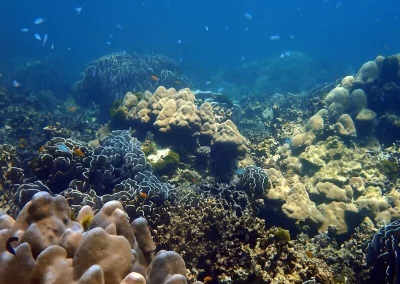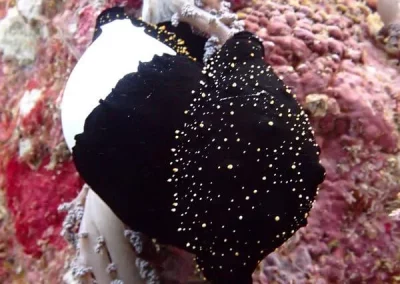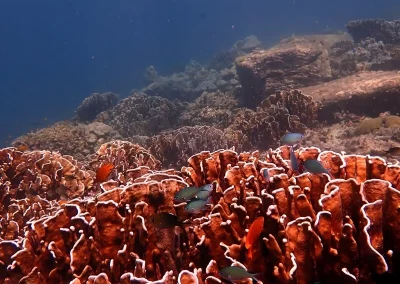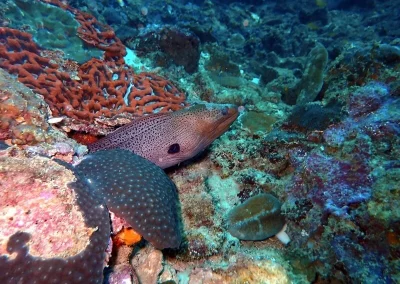Racha Noi

There are 8 commonly used dive sites around the island, as they offer the best conditions and marine life. On the West Coast the sites are rather rocky with more or less steep drop-offs and coral beds. Certain sites like Marina Bay offer some rock passages, giving a unique sensation to divers. The interior of the bay, like the Camera Bay site which precedes it when arriving from the North, has a very beautiful coral reef, dense, with rich marine life, but above all magnificent landscapes. These sites are accessible during the high season from December to April when the waves and winds arrive from the North East. When the winds turn to the South-West then it is the East coast which becomes the destination for our dives, with sites like Banana bay or Racha Noi bay further south. The crystal clear waters, white sand and lush greenery of the island provide a range of exceptional colors. The reefs composed of coral heads, areas of soft corals, and enormous rocks placed on the bottom are sure to amaze divers of all levels.
This destination has sites for divers of all levels and especially versatile sites with shallow and protected parts for beginners looking for experience, while experienced divers can follow the rocky drop-offs and descend deeper.
The North and South Points of the island offer two more oriented sites for experienced people, with strong currents and sites plumb at 30-40 meters depth. The southern tip remains the best place to see Manta rays from Phuket. Our favorite is South Tip but is only accessible a few days a year because the conditions can be extreme on this site with strong currents, but it is worth the detour because we have nothing comparable to this site on Phuket.
Marine Life at Racha Noi
The fauna is quite varied with a large number of different species, and some nice surprises for those who have good eyes and a little luck too. The dominance are the most common reef fish like damsels, parrotfish, butterflies, also various varieties of boxfish. Various moray eels (Gymnothorax) among the rocks and coral patches, but there are also many species of lion fish (Pterois) and scorpion fish (Rhinopias).
Some coral heads are covered with small transparent glass poles (Parambassis ranga) in schools of several thousand twirling from one direction to another to escape predators such as trevally (Caranx Ignobilis).
In the sand you can come across small blue-spotted stingrays (Taeniura Lymma) as well as eagle rays (Aetobatus narinari) on banana bay.
It is undoubtedly the Manta Ray (Manta Birostris) which wins the palme d’or of this destination, this majestic animal patrols around the islands from one site to another in search of plankton on which it mainly feeds. Or cleaning station to deparasite by cleaner wrasses (Labroides dimidiatus) among others.
Giant toadfish (antenarius commerson) are also found on the sites with bright colors and an exceptional shape that it is difficult to tell that it is a fish. Also another very rare animal is the pegasus fish (Eurypegasus Draconis).
Banana Bay
The reef is mainly made of hard corals, diving begins in the shallow part with large areas of sand ideal for beginners in training, and descends gently with coral spots here and there. Recently the reappearance of “stag horn” corals in the sand which had disappeared after the tsunami has brought new life and splendor to the site.
Marine life in Banana Bay
The marine life on this site mainly consists of reef fish such as parrotfish, butterflyfish, chestfish, moray eels, damselflies, triggerfish… and many others. It is not uncommon to come across a school of barracuda patrolling the bay, providing a magnificent spectacle in the clear waters of the bay.
It happens that you come across a zebra shark (or often called a “leopard”) because of its color as an adult, laying on the sand resting during the day, cuttlefish and stingrays also appear on the sandy bottom. The luckiest have the chance to cross paths with manta rays, which patrol the island in search of plankton and cleaning stations, the best season is from November to February because they then migrate north towards the Similan Islands and the chances are crossing them becomes weaker… but it remains possible.
Photo Gallery
Map & Site Characteristics

Depth: 5-30 meters
Current: ✩ Low-moderate
Marine Life: ✩✩
Marina Bay
Marine life in Marina Bay
The marine life on this site is mainly composed of reef fish with in the bay such as parrotfish, butterflyfish, chestfish, moray eels, damselflies, triggerfish… and many others. We often come across giant box fish and lion fish there. A Manta ray is also regularly seen looking for a cleaning station, they sometimes enter the bay, but it is on the outer pinnacle that they are most often encountered. The best season is from November to February because it then migrates north towards the Similan Islands and the chances of meeting them become lower… but it remains possible.
In the rocks there are some shrimps, octopuses and nudibranchs. Triggerfish on this site can be aggressive and protective of their habitat area, it is recommended to stay away.
Photo Gallery
Map & Site Characteristics

Depth: 8-40 meters
Current: ✩ Low-moderate
Marine Life: ✩✩
Camera Bay
The reef is mainly made up of hard corals, the dive begins in the shallow part with large areas of sand ideal for beginners in training, and descends gently with coral patches covering the sandy bottom.
Marine life in Camera Bay
The marine life is quite diverse on this site, there is obviously the common marine life of tropical reefs such as moray eels, fish, butterflies, parrots, lizards, but also the guides regularly find toad fish hiding in the corals.
Photographers and “Macro” enthusiasts will enjoy looking for nudibranchs, shrimps and small crabs on the rocks. Also like most sites on the island of Racha Noi you can come across a Manta Ray.
Photo Gallery
Map & Site Characteristics

Depth: 5-30 meters
Current: ✩ Low-moderate
Marine Life: ✩✩
Diving at Racha Noi
The choice of dive sites each day is the decision of the responsible Diving Manager on board the boat and is based on weather conditions, currents, visibility and the different dives on board. We cannot guarantee dive sites before departure.
Book your day trip now
Our Other Diving Sites

King Cruiser

Shark Point

Koh Doc Mai

Racha Yai

Bida Nok Phi Phi
Our Other Services

Diving Courses

Diving Liveaboards

Excursions & Tours






























